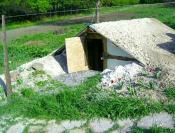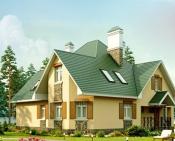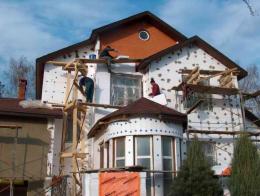Search
Login
Thermal insulation and insulation materials used in summer cottage construction and construction of private houses. Features of the choice of insulation
With the growing popularity of suburban and suburban construction, the issue of thermal insulation has become a topic of concern to many developers. The urgency of the issue is given by the considerable cost of fuel, or even simply the reluctance to mess with the stove for almost 9 months a year, when real living in the house can be deprived of comfort due to lower temperatures at night. In order to ensure coolness in the summer heat in a private house and reduce energy consumption in the cold season, it is customary to resort to the installation of thermal insulation.
Content
- What house designs need insulation video video
- On the qualitative characteristics of thermal insulation for walls, roofs and foundations video
- Liquid thermal insulation and its advantages
- Features of spray thermal insulation
- Natural linen insulation
What house designs are most in need of insulation
foundation
The correct installation of thermal insulation of the foundation will contribute to the durability of the entire structure, reduce the risk of deformation of its base under the influence of heaving of frozen soil, reduce heat loss of the whole house. The materials from which the foundation is made are constantly threatened by the influence of high humidity, therefore, heaters should be selected not prone to moisture absorption, for example - extruded polystyrene foam.

The material has a long service life, affordable price, simple processing and installation. Its main advantage is a very low coefficient of thermal conductivity, which allows polystyrene foam to perfectly retain heat inside the building.
floors
The second important point in the insulation of a private house is the floors. Here, too, material not prone to water absorption will be required. An ideal option would be the same polystyrene foam, polyurethane foam and polyethylene foam. A good option would be to use mineral wool, but subject to its hydrophobic impregnation. Mineral and basalt wool have a fairly long service life, have good heat saving performance.

For example, Rockwool thermal insulation allows you to get great savings on fuel consumption, while it has high strength and stiffness, is able to perfectly maintain its own shape stability. At the end of the operation cycle, it can be used as a secondary raw material in the production of thermal insulation.
Since, at the location of the floor, the boundary of cold and heat passes, it is completely expected that condensation will form. To protect the basalt insulation or mineral layer from moisture, installation of a vapor barrier membrane is required. It is possible to use foil as a vapor barrier layer, which also has reflective properties.
walls

The walls of a country house or a country house have a significant area and are more susceptible to the effects of street temperature, so their insufficient thermal insulation leads to significant heat loss in the cold season. Facade insulation is carried out both externally and internally. Experts recommend giving preference to external insulation: this will not cause a decrease in the usable area inside the structure and also will not lead to a shift of the dew point inside the wall. Naturally, the dry material from which the walls are built will have a longer service life.
Today in construction, two main types of external thermal insulation are used. The first of them is when the insulation for the house is attached to the wall and covered with a layer of plaster from above. You can apply this method for warming a country house or a capital country house built of any material: brick, wood, block structures. As a heater foam can be used, heat-saving mineral plasters.

The second method differs in that at first a layer of heat-insulating material is attached to the wall, then it is covered with a protection on top, which can be a decorative panel, siding, natural board. Facades insulated in this way are called ventilated, because between the insulation layer and the external finish during installation leave a space of several millimeters. As thermal insulation for walls in ventilated facades, polystyrene foam and basalt cotton wool are used.

roof
It will also be necessary to eliminate heat loss through the roof of the house. It is advisable to use materials for insulation of ceiling ceilings that are not only good heat-saving, but also light in weight - they should not contribute to an increase in the age of the roof structure, and consequently, to increased loads on walls and foundations.

From the commercially available insulation for the roof, you should choose the most lightweight, environmentally friendly, not able to emit toxic components. It can be polyethylene foam, polyfoam, polyurethane foam sprayed thermal insulation, ecowool. When arranging thermal insulation on stronger pitched and flat roofs, mineral and basalt cotton wool is used. A prerequisite for the quality work of the insulation will be the installation of a vapor barrier membrane under the insulation.
On the qualitative characteristics of thermal insulation for walls, roofs and foundations

All of the above implies the mandatory installation of a thermal insulation layer during the construction or repair of a country house, if you live in it throughout the year, or a private country house. But when choosing materials, one should nevertheless be guided not only by their heat-saving qualities, but also pay attention to other characteristics that can negatively affect the indoor environment or lead to the rapid destruction of heat-saving structures under the influence of negative factors.

Giving preference to this or that material we consider the following.
- Polyethylene foam is a non-toxic material for humans, but under the influence of the load it can deform and lose its heat-saving qualities.
- Expanded polystyrene releases a small amount of styrene.
- Polyurethane foam emits harmful impurities in very small amounts when heated.
Although all of the above materials are not prone to fire, they will still burn in a fire, emitting highly toxic smoke during combustion.
Mineral and basalt wool can be attributed to non-combustible materials, but it is advisable to use them only for performing external insulation - in the manufacture of the material phenol and formaldehyde harmful to humans are used. To increase the release of toxic substances contributes to a high ambient temperature, use these materials combining them with a detoxifying primer.

The most acceptable and safe in an environmentally friendly and firefighting plan material made from cellulose, the so-called ecowool. It is able to provide decent resistance to open fire, its fibers consist exclusively of natural components: recycled waste paper and borax or boric acid, which are flame retardants. As an astringent component, lignin is used - a natural polymer contained in wood. Ecowool does not emit harmful substances when used in different temperature conditions. Of its shortcomings, a relatively high cost can be noted.
Liquid thermal insulation and its advantages

There are many disadvantages inherent in other types of heat-insulating materials, liquid thermal insulation. In its manufacture, acrylic polymers, inorganic pigments and ceramic or silicone balls are used. After applying a layer of liquid insulation, a very thin, light, elastic film forms on the surface of the material. Any building materials that can be operated at temperatures from -40 to +250 degrees can be treated with liquid insulation. Some coating modifications do not lose their properties even when exposed to temperatures as high as 1000 degrees. The thermal insulation coating is resistant to mechanical damage, moisture and ultraviolet radiation.
High environmental friendliness of the material allows its use for external and internal works, and not only in housing construction, but also in the conditions of children's institutions or catering establishments.
Features of spray thermal insulation

The sprayed thermal insulation, which modern builders often choose, is ideal for warming structures, which are not desirable to weight. It has a low thermal conductivity and good waterproofing properties. With its use, the need for laying vapor-permeable and waterproofing membranes disappears. The application of the foam layer on metal surfaces reliably protects them from corrosion. A layer of foam protects the house from the penetration of street noise.
Natural linen insulation
Interesting and useful qualities are possessed by modern linen insulation made from natural raw materials. The tubular structure of its fiber has the ability to thermoregulate, which allows you to create a particularly comfortable atmosphere in the house at any time of the year. It does not cause allergies, is not able to accumulate static electricity. Its antiseptic properties prevent the growth of microorganisms and fungi, even if the material contains moisture. Thermal insulation properties and the internal structure of the fibers are preserved even after wetting. The material is not inclined to absorb moisture and allows it to evaporate easily, thereby protecting the house from the manifestation of symptoms of the greenhouse effect. The service life of flax insulation is from 60 to 75 years, it is not affected by temperature changes or ultraviolet radiation. The structure of the fibers allows you to create a highly porous structure with good acoustic performance, about a third higher than that of mineral wool.

Flax insulation in its composition contains exclusively natural materials, it does not exude harmful fumes when heated and is not a source of dust. Installation of linen insulation can be done without the use of protective clothing and mittens.
You can use the material for internal and external thermal insulation of walls, partitions, attics, balconies and frame houses. Such a heater helps to clean the air in the room, eliminates excess moisture.
This is not a complete list of heaters used today in private construction. It remains to add that the thickness of the insulation is calculated taking into account the average temperatures of the cold season, the material and wall thickness of the structure, the heat-saving coefficient of the insulation chosen by you.
When designing a house and performing construction and installation works, it is desirable to comply with the rules and technological standards - this will avoid unpleasant costs.





